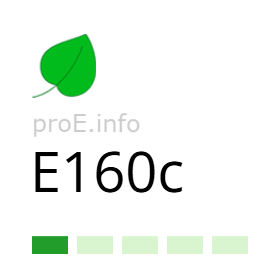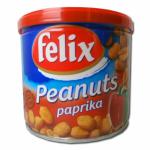
Other names for the additive (synonyms)
General Information
The food additive E160c (paprika oleoresin and paprika extract) belongs to the group of E160 additives and has a natural origin — it is obtained from natural paprika, the red chili pepper, which belongs to the genus Capsicum.
The main method for producing additive E160c is solvent extraction from the plant material. The solvents are removed from the final product.
Paprika oleoresin and paprika extract contains several pigments: carotene (provitamin A, a yellow pigment), capsanthin, and capsorubin. The composition of the colorant E160c also includes certain fatty acids — oleic, linolenic, stearic, palmitic, and myristic.
The additive E160c is often labeled in foods as “capsanthin” or “capsantene” — after its main coloring pigment.
This colorant is available in two forms — fat-soluble and water-dispersible. These types differ in method of production and use:
- E160c(i) — paprika oleoresin: fat-soluble form obtained by extracting carotenoids from paprika using organic solvents. It is used in fat-based foods such as oils, margarines, and meat products.
- E160c(ii) — paprika extract: a more versatile form that may be either fat-soluble or water-dispersible. Thanks to additional processing (e.g. with emulsifiers), it is used in low-fat or water-based products — sauces, snacks, drinks, and desserts.
The additive E160c is highly resistant to light and heat, allowing it to preserve food color in nearly any conditions. The use of paprika oleoresin and paprika extract enables food coloring in a wide range of shades — from peach to reddish-orange.
Key properties of additive E160c:
- Taste — almost neutral.
- Odor — specific, but removed during processing.
- Form — powder, liquid paste, or emulsion.
- Color — brownish-orange.
Effects on the Body
Benefits of additive E160c
Paprika oleoresin and paprika extract are considered as safe food additives. As they are derived from plants, they are classified as natural colorants. In moderate amounts, additive E160c may provide beneficial effects:
- improves blood circulation;
- stimulates gastric juice secretion and aids digestion;
- enhances appetite;
- provides a mild stimulating and tonic effect;
- has anti-inflammatory properties;
- helps relieve flatulence;
- may reduce chills and support the body during colds;
- helps stop ulcerative bleeding;
- supports the function of kidneys, spleen, lungs, pancreas, stomach, and heart.
Risks of additive E160c
In the official EFSA scientific evaluation of additive E160c (paprika oleoresin and paprika extract), no serious toxic effects were reported even at high intake levels.
However, exceeding the safe intake level (NOAEL) was associated with minor histopathological changes in tissues. Specifically, regular consumption of paprika extract above 24 mg/kg body weight per day may cause liver strain, especially in sensitive populations.
There are no known side effects from moderate consumption of additive E160c, although paprika and other red pepper species used in its production may trigger allergic reactions in certain individuals.
Uses
Additive E160c is used to color food products or to restore color lost during thermal processing. At higher concentrations, additive E160c may impart a pungent taste, especially noticeable in certain foods such as chips or cheese.
The fat-soluble colorant E160c is applied in products like:
- mayonnaise;
- margarine;
- chips;
- spreads;
- fat-based sauces.
The water-dispersible form of additive E160c is used in:
- dairy desserts;
- cheeses;
- water-based sauces;
- ice cream.
The colorant E160c is also commonly found in orange juice, spice blends, candies, and emulsified meat products.
Outside the food industry, additive E160c is used in poultry feed. It enhances the orange hue of egg yolks.
Legal Status
The use of paprika as additive E160c is approved in Ukraine, the EU, the United States, and most countries worldwide.
In the EU, the use of paprika oleoresin and paprika extract is regulated based on the EFSA report, which established two Acceptable Daily Intake (ADI) values:
- 24 mg/kg body weight per day — for the full E160c extract,
- 1.7 mg/kg body weight per day — based on total carotenoid content.



